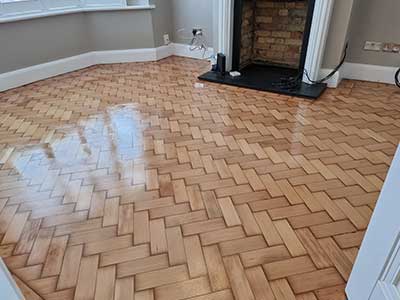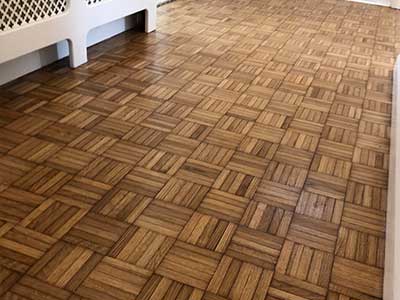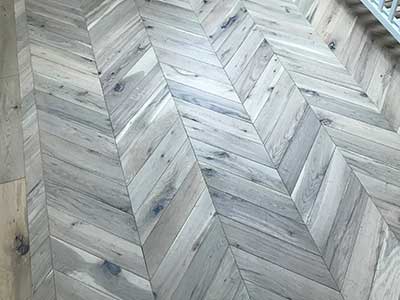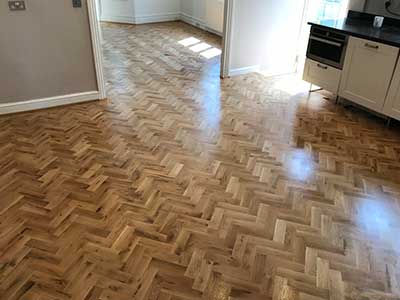Back to Parquet Restoration
Ultimate Guide to Parquet Floor Restoration and Maintenance
 Parquet flooring is a unique and elegant flooring option that is created by arranging small blocks or strips of wood into geometric patterns. These patterns add a decorative element to any space, making parquet a popular choice for those looking to add character to their floors. Some of the most common parquet patterns include Herringbone, where the wood blocks are laid at right angles to form a 'zigzag' effect, Chevron, which features a more angular design with blocks cut at angles, and Basketweave, a pattern that gives the illusion of interwoven wood strips.
Parquet flooring is a unique and elegant flooring option that is created by arranging small blocks or strips of wood into geometric patterns. These patterns add a decorative element to any space, making parquet a popular choice for those looking to add character to their floors. Some of the most common parquet patterns include Herringbone, where the wood blocks are laid at right angles to form a 'zigzag' effect, Chevron, which features a more angular design with blocks cut at angles, and Basketweave, a pattern that gives the illusion of interwoven wood strips.
Parquet floors are typically made from durable hardwood species like oak, walnut, and maple, each providing different colours and grain textures that further enhance intricate designs. These hardwoods not only contribute to the parquet’s stunning appearance but also ensure long-lasting durability and resilience against everyday wear.
When to Restore Your Parquet Floors
Over time, even the most well-maintained parquet floors will show signs of aging and wear, indicating the need for restoration. Some key signs that your parquet floors are due for a refresh include visible wear and tear, such as scratches, scuffs, and a loss of the original shine, leaving the surface looking dull. Gaps between the blocks may start to appear, signaling that the adhesive has weakened or the wood has contracted.
Water damage or noticeable stains are another clear indicator that restoration is necessary, especially if spills have penetrated the finish and affected the wood underneath. Additionally, uneven surfaces or loose blocks suggest that the structure of your parquet flooring may need attention to avoid further damage. Addressing these issues promptly through professional restoration will help maintain the beauty and longevity of your parquet floors.
Preparing for Restoration
Before you start the restoration process, proper preparation is key to achieving the best results.
Clearing the Room
Ensure the room is completely free of furniture and obstacles. This will give you full access to the entire surface and prevent any interruptions during the restoration process.
Checking for Damage
Carefully inspect the parquet floor for any loose or broken blocks. If you spot damaged areas, make a note of them as they will need to be fixed before sanding.
Tools and Materials You’ll Need
Gather all the necessary tools and materials before starting the restoration:
- Sanding machines: For smoothing the surface and removing old finishes
- Wood filler: To repair gaps between the parquet blocks
- Finishing products: Including stains, sealers, or varnishes to protect and enhance the floor's appearance
- Protective gear: Masks and goggles to shield from dust and debris
Being fully prepared will streamline the restoration process and help ensure top-quality results.
Parquet Sanding Techniques
 Sanding parquet floors requires a delicate approach to preserve their unique patterns and beauty. Here are some key techniques to keep in mind:
Sanding parquet floors requires a delicate approach to preserve their unique patterns and beauty. Here are some key techniques to keep in mind:
Choosing the Right Sanding Equipment
For parquet flooring, orbital or multi-directional sanders are ideal, as they can handle intricate patterns without damaging the wood. Traditional belt sanders may be too aggressive for parquet floors and could result in uneven sanding.
Sanding with the Grain
Unlike traditional planks, parquet flooring consists of wood blocks laid in various patterns. Sanding with the grain of each block is crucial to avoid scratching and damaging the surface. For intricate patterns like Herringbone or Chevron, take extra care to follow the natural direction of each block.
Tackling Intricate Patterns
When sanding detailed parquet designs, work slowly and use finer sandpaper to prevent over-sanding any area. Take your time on intricate areas to preserve the pattern's integrity and avoid inconsistencies.
Sanding Edges and Hard-to-Reach Spots
For edges and tight spots, use a corner or edge sander with finer grit paper. This ensures even sanding without leaving rough patches or scratches. Be careful around skirting boards or other fixed obstacles to avoid damage.
Repairing Gaps and Loose Blocks
Over time, parquet floors may develop gaps between the blocks or experience loosening. Here's how to address these issues:
Filling Gaps Between Parquet Blocks
- Using Resin Fillers: For smaller gaps, resin fillers are an excellent solution. These fillers are mixed with fine wood dust to match the colour of your parquet floor, providing a smooth and consistent finish.
- Colour Matching Fillers: To maintain the floor's seamless appearance, choose colour-matching fillers. This ensures that the filler blends in with the natural wood tones of the parquet, repairing nearly invisible.
Replacing or Refitting Loose Blocks
- Remove Loose Blocks: Carefully lift any loose blocks using a chisel, being mindful not to damage surrounding blocks.
- Refitting Blocks: Apply adhesive to the block and secure it back into place.
- Replacing Damaged Blocks: If the block is beyond repair, replace it with a new one of the same size and wood type. Sand and finish the new block to match the rest of the floor.
Finishing Your Restored Parquet Floor
 After restoring your parquet floor, the right finish will enhance its beauty and protect it for years to come. Here's how to finish it effectively:
After restoring your parquet floor, the right finish will enhance its beauty and protect it for years to come. Here's how to finish it effectively:
Choosing the Best Finish for Parquet
- Lacquer: Provides a durable, high-gloss finish that protects against wear and scratches. Ideal for high-traffic areas.
- Oil: Penetrates deeply into the wood, offering a natural look with a satin finish. It highlights the grain of the wood but may need more regular maintenance.
- Wax: Gives the floor a soft, matt finish and is easy to repair, but it requires more frequent reapplication than lacquer or oil.
Applying the Finish Evenly
- Use a roller or brush to apply the finish in even strokes.
- Always follow the grain of the wood to prevent streaks or uneven coverage.
- Apply multiple thin coats for better durability and appearance.
Polishing Tips for a Smooth, Glossy Finish
- Once the finish is applied, allow it to dry completely before polishing.
- Use a soft buffing pad to polish the surface and achieve a smooth, glossy finish.
- For oil or wax finishes, additional polishing can enhance the shine.
Drying and Curing Time
- Allow at least 24 hours for the finish to dry between coats.
- Full curing can take up to a week, so avoid heavy traffic during this time for optimal results.
Maintaining Your Restored Parquet Floor
To keep your restored parquet floor looking its best, regular care and attention are essential. Here are some practical tips to maintain its beauty and longevity:
Daily Care Tips
- Dusting and Vacuuming:
- Use a soft-bristled broom or a vacuum with a hard floor setting to remove dust and debris without scratching the surface.
- Avoid using vacuums with rotating brushes, which can damage the wood.
- Microfiber mops are ideal for dusting, as they trap dust effectively without leaving scratches.
Avoiding Moisture Damage and Scratches
- Prevent moisture exposure:
- Wipe up spills immediately to avoid water seeping into the wood and causing warping or stains.
- Place rugs or mats in areas prone to moisture, like near entryways or kitchens.
- Furniture pads:
- Add felt pads to furniture legs to prevent scratches when moving chairs or tables.
- No high heels:
- Avoid wearing high heels on the parquet floor as they can leave dents or marks.
 Reapplying Protective Layers Periodically
Reapplying Protective Layers Periodically
- To maintain the finish and protect your parquet, reapply lacquer, oil, or wax as needed.
- Lacquer typically needs reapplication every 3-5 years.
- Oil and wax finishes require more frequent reapplications, every 1-2 years, depending on traffic.
- Light sanding before reapplying the protective layer helps the new finish adhere better and enhances the floor's appearance.
Best Cleaning Products for Parquet
- pH-neutral cleaners specifically formulated for wood floors are recommended to avoid damage.
- Avoid harsh chemicals like ammonia or abrasive cleaners that can strip the finish and damage the wood.
- For oil-finished floors, use maintenance oils periodically to nourish and preserve the wood.
Restoring and maintaining your parquet floor is a rewarding investment that enhances the beauty and value of your home. By understanding the characteristics of parquet flooring and following proper restoration techniques, you can revive its original charm and ensure its longevity. Regular maintenance, including careful cleaning and protective treatments, will keep your parquet looking stunning for years to come. Whether you're restoring an old floor or caring for a recently restored one, these practices will help you enjoy the elegance of parquet in your living space.